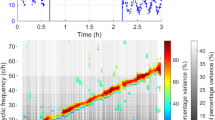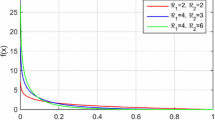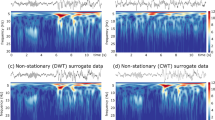Abstract
Least-squares spectral analysis, an alternative to the classical Fourier transform, is a method of analyzing unequally spaced and non-stationary time series in their first and second statistical moments. However, when a time series has components with low or high amplitude and frequency variability over time, it is not appropriate to use either the least-squares spectral analysis or Fourier transform. On the other hand, the classical short-time Fourier transform and the continuous wavelet transform do not consider the covariance matrix associated with a time series nor do they consider trends or datum shifts. Moreover, they are not defined for unequally spaced time series. A new method of analyzing time series, namely, the least-squares wavelet analysis is introduced, which is a natural extension of the least-squares spectral analysis. This method decomposes a time series to the time–frequency domain and obtains its spectrogram. In addition, the probability distribution function of the spectrogram is derived that identifies statistically significant peaks. The least-squares wavelet analysis can analyze any non-stationary and unequally spaced time series with components of low or high amplitude and frequency variability, including datum shifts, trends, and constituents of known forms, by taking into account the covariance matrix associated with the time series. The outstanding performance of the proposed method on synthetic time series and a very long baseline interferometry series is demonstrated, and the results are compared with the weighted wavelet Z-transform.










Similar content being viewed by others
References
Abd El-Gelil M, Pagiatakis SD, El-Rabbany A (2008) Frequency-dependent atmospheric pressure admittance of superconducting gravimeter records using least-squares response method. Phys Earth Planet Inter 170(1–2):24–33. doi:10.1016/j.pepi.2008.06.031
Amato U, Antoniadis A, Pensky M (2006) Wavelet kernel penalized estimation for non-equispaced design regression. Stat Comput 16(1):37–55. doi:10.1007/s11222-006-5283-4
Barnhart BL (2011) The Hilbert–Huang transform: theory, application, development. Ph.D. Thesis, University of Iowa
Baydar N, Ball A (2001) A comparative study of acoustic and vibration signals in detection of gear failures using Wigner–Ville distribution. Mech Syst Signal Process 15(6):1091–1107. doi:10.1006/mssp.2000.1338
Brown RG, Hwang PYC (2012) Introduction to random signals and applied Kalman filtering. John Wiley and Sons, Inc, New Jersey, p 383
Campbell J (2004) VLBI for geodesy and geodynamics, the role of VLBI in astrophysics, astrometry and geodesy, Chap. 22. NATO Sci Seri II Math Phys Chem 135:359–381
Chen Y, Feng MQ (2003) A technique to improve the empirical mode decomposition in the Hilbert-Huang transform. Earthq Eng Eng Vib 2(1):75–85. doi:10.1007/BF02857540
Classen TACM, Mecklenbrauker WFG (1980a) The Wigner distribution: a tool for time-frequency analysis. Part I: Continuous-time signals. Philips J Res 35:217–250
Classen TACM, Mecklenbrauker WFG (1980b) The Wigner distribution: a tool for time-frequency analysis. Part II: Discrete-time signals. Philips J Res 35:276–300
Classen TACM, Mecklenbrauker WFG (1980c) The Wigner distribution: a tool for time-frequency analysis. Part III: Relations with other time-frequency signal transformations. Philips J Res 35:372–389
Cohen A, Daubechies I, Feauveau JC (1992) Biorthogonal bases of compactly supported wavelets. Commun Pure Appl Math 45(5):485–560. doi:10.1002/cpa.3160450502
Craymer MR (1998) The least-squares spectrum, its inverse transform and autocorrelation function: theory and some application in geodesy. Ph.D. Thesis, University of Toronto, Canada
Foster G (1996) Wavelet for period analysis of unevenly sampled time series. Astron J 112(4):1709–1729
Gabor D (1946) Theory of communication. J IEE 93(26):429–457. doi:10.1049/ji-3-2.1946.0074
Gilles J (2013) Empirical wavelet transform. IEEE Trans Signal Process 61(16):3999–4010. doi:10.1109/TSP.2013.2265222
Guang Y, Sun X, Zhang M, Li X, Liu X (2014) Study on ways to restrain end effect of Hilbert-Huang transform. J Comput 25(3):22–31
Hall P, Turlach BA (1997) Interpolation methods for nonlinear wavelet regression with irregularly spaced design. Ann Stat 25(5):1912–1925. doi:10.1214/aos/1069362378
Harville DA (2008) Matrix algebra from a statistician’s perspective. Springer Science and Business Media LLC, Berlin, p 630
Hayashi T, Yoshida N (2005) On covariance estimation of non-synchronously observed diffusion processes. Bernoulli 11(2):359–379. doi:10.3150/bj/1116340299
Hlawatsch F, Boudreaux-Bartels F (1992) Linear and quadratic time-frequency signal representations. IEEE Signal Proc Mag 9(2):21–67. doi:10.1109/79.127284
Huang NE, Wu Z (2008) A review on Hilbert-Huang transform: method and its applications to geophysical studies. Rev Geophys 46:23. doi:10.1029/2007RG000228
Huang NE, Wu Z (2009) Ensemble empirical mode decomposition: a noise-assisted data analysis method. Adv Adapt Data Anal. doi:10.1142/S1793536909000047
Huang NE, Shen Z, Long SR, Wu MC, Shih HH, Zheng Q, Yen NC, Tung CC, Liu HH (1998) The empirical mode decomposition and the Hilbert spectrum for nonlinear and non-stationary time series analysis. Proc R Soc Lond A 454:903–995. doi:10.1098/rspa.1998.0193
Hui Y, Pagiatakis SD (2004) Least-squares spectral analysis and its application to superconducting gravimeter data analysis. Geo Spat Inf Sci 7(4):279–283. doi:10.1007/BF02828552
Johnson NL, Kotz S, Balakrishnan N (1995) Continuous univariate distributions, 2 (2nd ed.). Wiley. ISBN 978-0-471-58494-0
Kay SM, Marple SL (1981) Spectrum analysis a modern perspective. Proc IEEE 69(11):1380–1419. doi:10.1109/PROC.1981.12184
Lomb NR (1976) Least-squares frequency analysis of unequally spaced data. Astrophys Space Sci 39(2):447–462. doi:10.1007/BF00648343
Mallat S (1999) A wavelet tour of signal processing. Academic Press, Cambridge, p 637
Mathias A, Grond F, Guardans R, Seese D, Canela M, Diebner HH (2004) Algorithms for spectral analysis of irregularly sampled time series. J Stat Softw 11(2):27. doi:10.18637/jss.v011.i02
Pagiatakis SD (1999) Stochastic significance of peaks in the least-squares spectrum. J Geodesy 73(2):67–78. doi:10.1007/s001900050220
Pagiatakis SD, Yin H, Abd El-Gelil M (2007) Least-squares self coherency analysis of superconducting gravimeter records in search for the Slichter triplet. Phys Earth Planet Inter 160:108–123. doi:10.1016/j.pepi.2006.10.002
Psimoulis P, Pytharouli S, Karambalis D, Stiros S (2008) Potential of global positioning system (GPS) to measure frequencies of oscillations of engineering structures. J Sound Vib 318(3):606–623. doi:10.1016/j.jsv.2008.04.036
Puryear CI, Portniaguine ON, Cobos CM, Castagna JP (2012) Constrained least-squares spectral analysis: application to seismic data. Geophysics 77(5):143–167. doi:10.1190/geo2011-0210.1
Qian S (2002) Introduction to time–frequency and wavelet transforms. Prentice-Hall Inc., Upper Saddle River
Rao CR, Mitra SK (1971) Generalized inverse of matrices and its applications. John Wiley, New York, p 240. ISBN: 0471708216, 9780471708216
Rehfeld K, Marwan N, Heitzig J, Kurths J (2011) Comparison of correlation analysis techniques for irregularly sampled time series. Nonlinear Process Geophys 18:389–404. doi:10.5194/npg-18-389-2011
Ren H, Wang YL, Huang MY, Chang YL, Kao HM (2014) Ensemble empirical mode decomposition parameters optimization for spectral distance measurement in hyperspectral remote sensing data. Remote Sens 6(3):2069–2083. doi:10.3390/rs6032069
Sardy S, Percival DB, Bruce AG, Gao H, Stuetzle W (1999) Wavelet shrinkage for unequally spaced data. Stat Comput 9(1):65–75. doi:10.1023/A:1008818328241
Scargle JD (1982) Studies in astronomical time series analysis: II statistical aspects of spectral analysis of unevenly spaced data. Astrophys J Part 1 263:835–853. doi:10.1086/160554
Selesnick IV (2011) Wavelet transform with tunable Q-factor. IEEE Trans Signal Process 59:3560–3575. doi:10.1109/TSP.2011.2143711
Shapiro HS, Silverman RA (1960) Alias-free sampling of random noise. J Soc Ind Appl Math 8(2):225–248. doi:10.1137/0108013
Sinha S, Routh PS, Anno PD, Castagna JP (2005) Spectral decomposition of seismic data with continuous-wavelet transform. Geophysics 70(6):19–25. doi:10.1190/1.2127113
Steeves RR (1981) A statistical test for significance of peaks in the least-squares spectrum. Collected papers of geodetic survey, Dept. of energy, mines and resources, surveys and mapping, Ottawa, pp 149–166
Stein EM, Shakarchi R (2003) Fourier analysis. Princeton University Press, Princeton
Titov O (2002) Spectral analysis of the baseline length time series from VLBI data. IVS General Meeting Proc pp 315–319
Vanicek P (1969) Approximate spectral analysis by least-squares fit. Astrophys Space Sci 4(4):387–391. doi:10.1007/BF00651344
Vanicek P (1971) Further development and properties of the spectral analysis by least-squares. Astrophys Space Sci 12(1):10–73. doi:10.1007/BF00656134
Vanicek P, Krakiwsky EJ (1986) Geodesy the concepts. University of New Brunswick, Canada, Amsterdam
Wells DE, Vanicek P, Pagiatakis SD (1985) Least-squares spectral analysis revisited. University of New Brunswick, Canada, Department of Surveying Engineering
Wu DL, Hays PB, Skinner WR (2010) A least-squares method for spectral analysis of space-time series. J Atmos Sci 52:3501–3511. doi:10.1175/1520-0469(1995)
Acknowledgements
This research has been financially supported by the Natural Sciences and Engineering Research Council of Canada (NSERC) and partially by the Carbon Management Canada (CMC) National Centre of Excellence (Canada). The authors would like to thank the editor and the anonymous reviewers for their time and essential comments (especially comparing the LSWA with the Foster’s method) that significantly improved the presentation of the paper.
Author information
Authors and Affiliations
Corresponding author
Appendix A: Derivation of Eq. (10)
Appendix A: Derivation of Eq. (10)
A similar methodology is used as in Wells et al. (1985) and Craymer (1998) to obtain Eq. (10). From the model \(\mathbf {y}=\overline{\mathbf {\Phi }}\ \mathbf {\overline{c}}=\underline{\mathbf {\Phi }}\ \mathbf {\underline{c}}+ \mathbf {\Phi }\ \mathbf {c}\), estimate \(\mathbf {\overline{c}}\) using the least-squares method as \(\hat{\mathbf {\overline{c}}}=\mathbf {\overline{N}}^{-1}\overline{\mathbf {\Phi }}^\mathrm{T} \mathbf {P}_{\mathbf {y}} \mathbf {y}\), where \(\mathbf {\overline{N}}=\overline{\mathbf {\Phi }}^\mathrm{T} \mathbf {P}_{\mathbf {y}}\overline{\mathbf {\Phi }}\). Now write \(\mathbf {\overline{N}}^{-1}\) as
where
and \(\mathbf {\underline{N}}=\underline{\mathbf {\Phi }}^\mathrm{T} \mathbf {P}_{\mathbf {y}}\underline{\mathbf {\Phi }} \). Thus, from
one obtains
where \(\mathbf {N}=\mathbf {M_4}^{-1}=\mathbf {\Phi }^\mathrm{T}\mathbf {P}_{\mathbf {y}}\mathbf {\Phi }-\mathbf {\Phi }^\mathrm{T}\mathbf {P}_{\mathbf {y}}\mathbf {\underline{\Phi }}\ \mathbf {\underline{N}}^{-1}\mathbf {\underline{\Phi }}^\mathrm{T}\mathbf {P}_{\mathbf {y}}\mathbf {\Phi }\), and \(\hat{\mathbf {g}}=\mathbf {y}-\mathbf {\underline{\Phi }}\ \mathbf {\underline{N}}^{-1} \mathbf {\underline{\Phi }}^\mathrm{T}\mathbf {P}_{\mathbf {y}} \mathbf {y}\) is the estimated residual segment. Note that for each frequency, \(\mathbf {N}\) is a square matrix of order two, and so its inverse is computationally efficient.
Rights and permissions
About this article
Cite this article
Ghaderpour, E., Pagiatakis, S.D. Least-Squares Wavelet Analysis of Unequally Spaced and Non-stationary Time Series and Its Applications. Math Geosci 49, 819–844 (2017). https://doi.org/10.1007/s11004-017-9691-0
Received:
Accepted:
Published:
Issue Date:
DOI: https://doi.org/10.1007/s11004-017-9691-0




